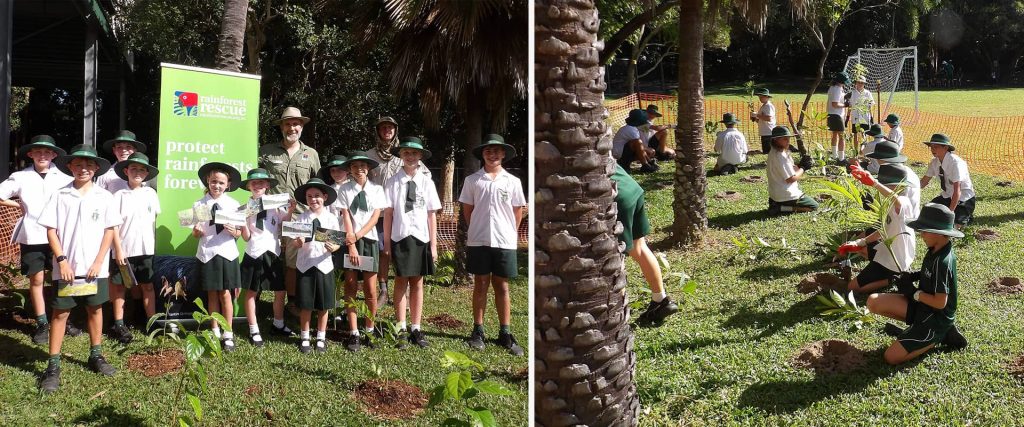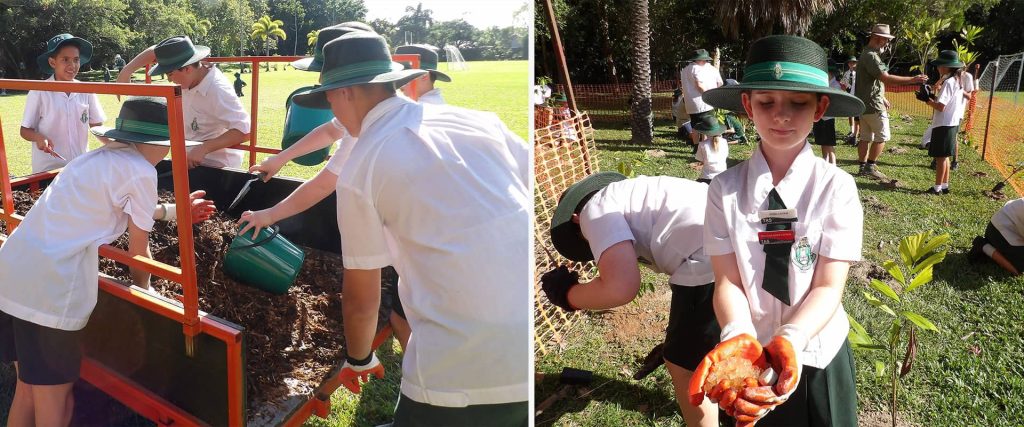‘Hope lies in what we choose to do next’ — Planting a pocket rainforest with local FNQ students

TAS Round Square students lead the planting of their pocket rainforest with Rainforest Rescue.
Ask any member of the Rainforest Rescue team when they first discovered their passion for the natural world and we guarantee they’ll say, ‘at school’ or ‘when I was young.’
Which is why we enjoy the opportunity to spend time in the local community, giving school students the chance to connect directly with native wildlife and plants, share knowledge, and deepen their appreciation of the natural world.
Thanks to the international Round Square program, Rainforest Rescue has collaborated with Trinity Anglican School (TAS) in Cairns on not one but two ‘pocket rainforest’ projects. You may recall that TAS Round Square student Nikita (she’s also a tree planting regular of Rainforest Rescue’s) orchestrated a planting at their White Rock Campus—and we even appeared on TV alongside her in 2024—thanks Nikita!
This time, it was students and teachers at TAS’ other campus in the Cairns Northern Beaches that were keen for us to plant a pocket rainforest with them. And as it turns out, the local wildlife was even keener!
Understanding rainforest ecosystems
Dan and Mark from the Rainforest Rescue team arrived bright and early at the Kewarra Beach Campus to help the students to get up close to native plants. The Round Square program encourages students to interact with Environmentalism as a theme, with a Commitment to Sustainability and a sense of Inquisitiveness as ‘Discovery’ attributes.
To support this, our tree planting sessions mix learning and active participation so that students can:
- Understand what a rainforest is and how it contributes to the planet’s climate and biodiversity
- Discover some of the keystone species of the rainforest and understand the relationship between plants and animals
- Learn how to care for a natural habitat and what factors are important for successfully restoring a natural space
- Work together to prepare, plant and maintain a pocket rainforest
 Mulch and water crystals help the young trees to settle into their new home by retaining moisture in the soil for longer.
Mulch and water crystals help the young trees to settle into their new home by retaining moisture in the soil for longer.
Conservation conversations
Our students on the day were a mix of ages from the school cohort, each with different areas of interest and an energetic willingness to get stuck in and ‘plant a rainforest!’ By restoring a natural area, students can learn about the different species planted, discover what happens to the plants as they grow, and how the different climatic conditions over a calendar year affect their physiology.
Within minutes of planting our first tree, we’d been ‘greeted’ by an eager Australasian figbird (Sphecotheres vieilloti), heartily pooping on Mark’s ranger shirt! Handily, it was a useful way to discuss how seeds are dispersed by birds and bats.
Conversations about the wonders of Cassowary poop are a perfect way to engage students in nature’s cycles and the connections within an ecosystem. They also break the ice when chatting with people of different ages at school, as poop seems to be a universally fascinating topic! (Who says that you should never work with children and animals?!)
The pocket rainforest planting area was adjacent to a mix of naturally regenerated and intact Melaleuca habitat, typical of the lowland plains in this part of the Wet Tropics region. Our plants were carefully selected by the Nursery Team, with fast-growing pioneer species that would support slower maturing native palms and trees. Collectively they will form an area that fulfils several purposes – partly to provide screening, partly to create a shady, connected corner for native wildlife and to establish a reliable food source for the various species we observed. Together, these aspects also give the students and teachers topics of learning and discussion around regenerative and ecological themes.
New neighbours
Once the plants were in their new homes and the students had carefully fed, watered and mulched the pocket rainforest, it was time to say thanks. Right on cue, the young habitat received its first wild attention. Agile wallabies (Macropus agilis), a northern Australian species, are a regular sight around the northern beaches of Cairns. TAS’ sports fields are dotted with wallabies grazing and seeking out young shoots for food. Freshly planted trees are just right for a quick snack!
So, for now, the pocket rainforest will be protected from too much wallaby interest, but in time these curious neighbours will be able to roam amongst the growing trees and seek shelter from the sun and rain.
This inquisitiveness also gave us further points of discussion—how do we manage the reintroduction of wild spaces into a developed place; what might happen in the coming months and years as the plants begin to mature and grow at different rates; what factors need to be considered as the habitat evolves. For the students, these topics provoked energetic discussion and a sense of custodianship, just as we intended.
For schools and their students, a pocket rainforest is a perfect place to learn more, now and into the future.
If your school or workplace in Far North Queensland is interested in planting trees and restoring habitat, please contact us to discuss how we can help.
Due to the generosity of Foundation for Rural & Regional Renewal (FRRR), Rainforest Rescue was able to facilitate this rewarding encounter with native flora and fauna.
#TreesAreTheAnswer #NextGenRainforestRescuers
Want more good Rainforest news in your life?
Subscribe to our eNews | Follow us on Instagram | Like us on Facebook | Subscribe to our YouTube channel
Help Protect Rainforests Forever
Donate to Protect Rainforests Forever | Become a Rainforest Guardian for as little as $2 a month | Partnership Options

